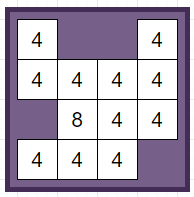Python程式:查詢滑動給定方向一次後的下一個棋盤位置
假設我們有一個表示初始棋盤的 2048 遊戲棋盤和一個表示滑動方向的字串,我們需要找到下一個棋盤狀態。眾所周知,在 2048 遊戲中,我們得到一個 4 x 4 的數字棋盤(其中一些是空的,這裡用 0 表示),我們可以向四個方向中的任意一個滑動(“U”、“D”、“L”或“R”)。當我們滑動時,所有數字都儘可能地向該方向移動,並且相同的相鄰數字恰好加起來一次。
因此,如果輸入類似於

direction = "L",則輸出將為

為了解決這個問題,我們將遵循以下步驟
如果 direction 等於 "R",則
board := 將棋盤逆時針旋轉兩次
否則,當 direction 等於 "U" 時,則
board := 將棋盤逆時針旋轉一次
否則,當 direction 等於 "D" 時,則
board := 將棋盤逆時針旋轉三次
對於 i 從 0 到 3,執行
row := board[i] 中所有非零元素的列表
對於 j 從 0 到 2,執行
如果 j + 1 小於 row 的大小且 row[j] 等於 row[j + 1],則
row[j] := row[j] * 2
移除 row[j + 1]
當 row 的大小小於 4 時,執行
在 row 的末尾插入 0
board[i] := row
如果 direction 等於 "R",則
board := 將棋盤逆時針旋轉兩次
否則,當 direction 等於 "U" 時,則
board := 將棋盤逆時針旋轉三次
否則,當 direction 等於 "D" 時,則
board := 將棋盤逆時針旋轉一次
返回 board
讓我們看看以下實現以更好地理解
示例
class Solution: def solve(self, board, direction): if direction == "R": board = rot_anti_clock_dir(rot_anti_clock_dir(board)) elif direction == "U": board = rot_anti_clock_dir(board) elif direction == "D": board = rot_anti_clock_dir(rot_anti_clock_dir(rot_anti_clock_dir(board))) for i in range(4): row = [x for x in board[i] if x] for j in range(3): if j + 1 < len(row) and row[j] == row[j + 1]: row[j] *= 2 del row[j + 1] while len(row) < 4: row += [0] board[i] = row if direction == "R": board = rot_anti_clock_dir(rot_anti_clock_dir(board)) elif direction == "U": board = rot_anti_clock_dir(rot_anti_clock_dir(rot_anti_clock_dir(board))) elif direction == "D": board = rot_anti_clock_dir(board) return board def rot_anti_clock_dir(x): x = [[x[i][j] for i in range(4)] for j in range(4)] return x[::-1] ob = Solution() matrix = [ [2, 0, 0, 2], [2, 2, 2, 2], [0, 4, 2, 2], [2, 2, 2, 0]] print(ob.solve(matrix, "L"))
輸入
matrix = [ [2, 0, 0, 2], [2, 2, 2, 2], [0, 4, 2, 2], [2, 2, 2, 0]]
輸出
[ [4, 0, 0, 0], [4, 4, 0, 0], [4, 4, 0, 0], [4, 2, 0, 0]]

廣告

 資料結構
資料結構 網路
網路 關係型資料庫管理系統
關係型資料庫管理系統 作業系統
作業系統 Java
Java iOS
iOS HTML
HTML CSS
CSS Android
Android Python
Python C語言程式設計
C語言程式設計 C++
C++ C#
C# MongoDB
MongoDB MySQL
MySQL Javascript
Javascript PHP
PHP